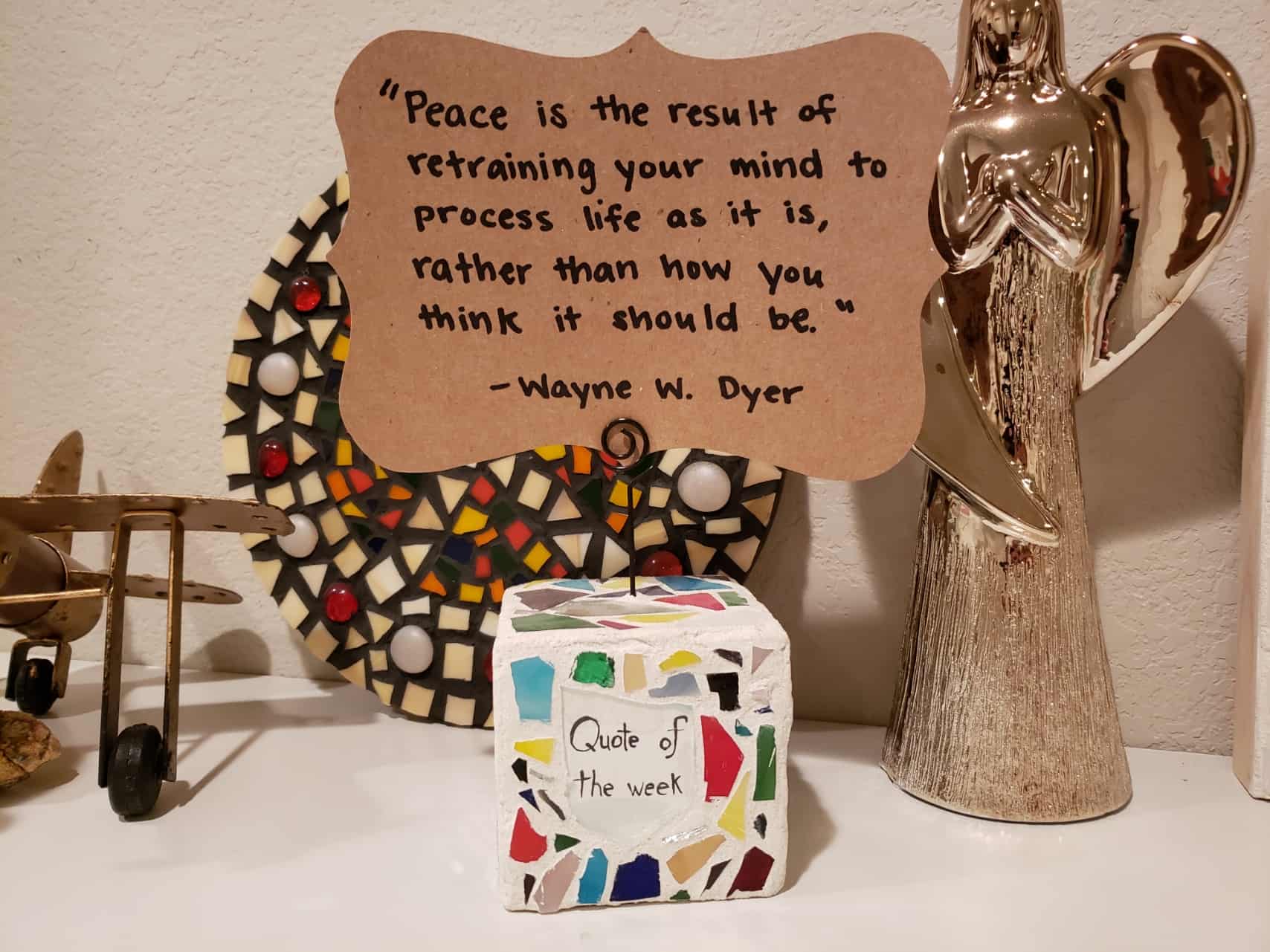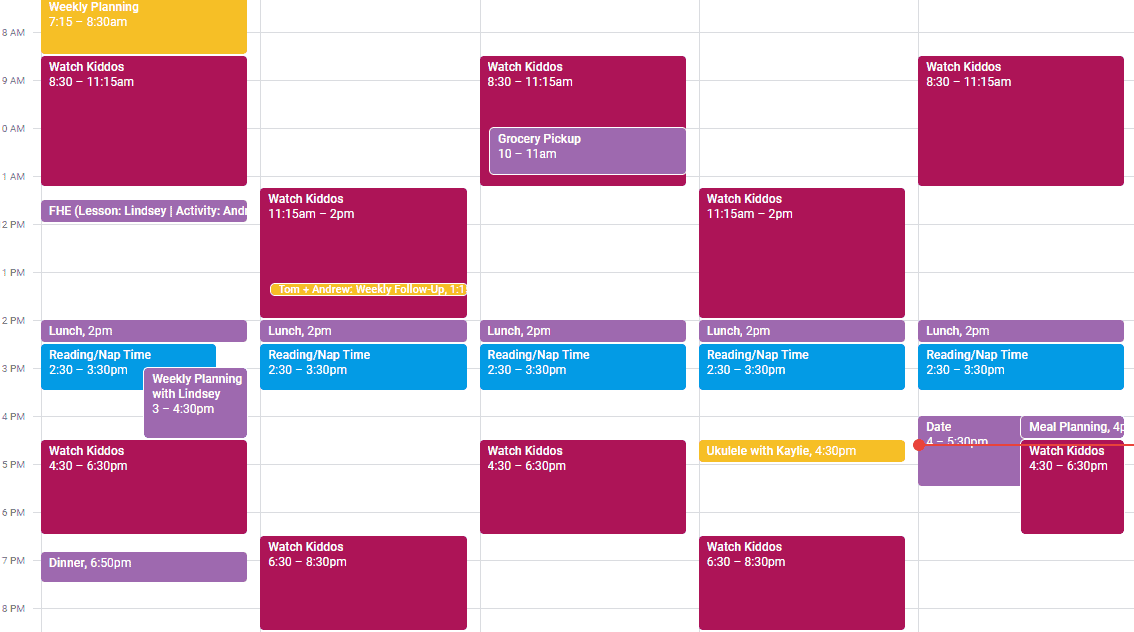How We Do Weekly Family Meetings
You might think meetings are for work, but your family is the most important organization and YOU are the CEO. This is why I think of the weekly meeting as the most important parenting habit. In this article, I want to give you an inside look at how we conduct our family meetings.
Why the Weekly Family Meeting
Before we jump into the ins and outs of how we conduct our weekly family meeting, I want to share 6 reasons why it is so important. The weekly family meeting is essential because:
- An intentional family culture must be planned. A CEO’s most important focus is on the culture of his/her company. As a parent, your most important role is to ensure that your family’s culture will lead to the development of the children and family you want in the long run. Culture consists of shared behaviors, beliefs, and values. Culture is all about unity, and the family meeting is the perfect opportunity to get everyone on the same page.
- You must plan ahead if you want consistent family traditions. Traditions are the backbone of any strong organizational culture. Traditions are shared behaviors that happen at the same time over and over again. To attain the kind of consistency that traditions require, careful planning is paramount. Getting ready the day of or the day before an important family tradition won’t cut it.
“To attain the kind of consistency that traditions require, careful planning is paramount.”
- Meaningful experiences rarely happen when we are too preoccupied with day-to-day family chores. If your day-to-day is filled with questions such as “What are we going to have for dinner tonight?” you will likely find it challenging to soak in meaningful time with your family. The weekly family meeting allows you to get the business of family life out of the way so that you spend the rest of your time soaking in the joys of family life.

- Relationships require regular attention. Let an unresolved conflict sit for too long and it will start to fester. The weekly meeting provides a regular opportunity to resolve conflicts between family members.
- Regular family meetings allow you to work together towards big family goals. The real issue with New Year’s resolutions is that most people set the goal and then forget about it. If they were to regularly check their progress, they’d be much more likely to achieve these goals. The family meeting allows us to check in regularly and break the bigger goals into smaller, manageable chunks.
- You can easily stack new family habits onto the weekly family meeting once it is well established. One of the best ways to form a new habit is to stack it onto an existing habit. Let’s say you are not getting the mail as often as you need to. If you already do the family meeting on a weekly basis, you can stack your new mail habit onto the existing family meeting habit. By stacking a new habit onto an existing habit, you are much more likely to develop the new habit.

WHO TO INVOLVE
If you have young children, you are likely thinking, “I can barely get them to sit still for 5 minutes, let alone an entire meeting!” Never fear. The beauty of the family meeting is that you can break it up into multiple smaller meetings. You could have a Whole Family meeting, an Older Kids Meeting, and a Parent Meeting.
WHAT TO TALK ABOUT DURING A WHOLE FAMILY MEETING
We’ve been doing these meetings for years and are constantly adding, subtracting, and adjusting what we discuss. If something in here doesn’t sound like a good fit for your family, don’t do it. Additionally, try not to get overwhelmed by all the different discussion items. If you are just getting into family meetings, just choose your top 5 to keep it simple at first. Your initial goal is to make these meetings into habits. You can always add, subtract, and optimize to your heart’s content down the road.
Since our kids are currently young, we just focus on the most important items of business during the Whole Family Meeting. To me, the most important job of a family is maintaining its family culture. For this reason, we focus on our family values during this meeting. Here’s our current agenda for this meeting:
- Gratitude Notes. Displayed in our home, we have a gratitude jar in which we put notes saying what we are grateful for throughout the week. During our Whole Family Meeting, we read each of these notes out loud. Then we count down, “3, 2, 1” and shout “We’re grateful” over and over as we throw the notes up in the air like confetti. It’s a really fun weekly family tradition that highlights our family value of gratitude.

Our Family Gratitude Jar
- Quote of the Week. Next, we recite our quote of the week, which relates to our value of the week (we have 16 family values that we rotate through). Any family member who memorized the quote can recite it, earning them a small prize. Then we read next week’s quote of the week and put it on display.

Our Quote of the Week on Display
- Values-related YouTube Video. Finally, we watch a short YouTube video that relates to the family value of the week. Once the kids are older, we may also discuss the video afterwards.
WHAT TO TALK ABOUT DURING AN OLDER KIDS MEETING
When our kids get older, we will start to involve them in some of the bigger picture planning items currently discussed during our Parent Meeting (see below). We may also discuss the goals they have for themselves.
WHAT TO TALK ABOUT DURING A PARENT MEETING
During our Parent Meeting, Lindsey and I discuss some things weekly, some monthly, some quarterly, and some yearly.
Weekly Discussion Items:
- Relationship Inventory. Before planning anything, Lindsey and I do a quick check-in to see how our relationship is going. We’ve adjusted the format over time, but currently our relationship inventory includes the following:
- Discuss Strengths of Our Relationship. First, we talk about things we are good at as a couple. What are we doing well together?
- Resolve Conflicts Using Nonviolent Communication. Next, we talk about anything that may be causing hard feelings that we haven’t had a chance to discuss yet. We try to use the language of nonviolent communication to express ourselves and understand each other fully (See “How Nonviolent Communication Completely Transformed My Relationships”).
- Share 2 Positives. For the last part of our relationship inventory, we tell each other two positive things we’ve noticed about the other person during the past week.
- Set and Share Goals. After the relationship inventory, we follow up on and set new goals:
- Share Personal Goals. First, we tell the other person what goals we have for ourselves for the upcoming week. Doing this provides us with an accountability partner, and it helps us get on the same page regarding what the other person will be focusing on (See “A Step-by-Step Guide to Goal Setting”)
- Review Last Week’s Goals. Next, we review the goals we had as a couple for the past week and see how we did.

- Update Habit Tracker. If we have a habit that we are working on together, we plug it into our habit tracker (Make your own copy by clicking here). The purpose of the habit tracker is to help us make a detailed plan for turning a behavior into a habit. It also allows us to track how well we are doing at turning the behavior into a habit. For each habit, we fill out the following on our habit tracker:
- Habit. We give our habit a name (i.e. “doing laundry”).
- Frequency. We decide how often we’d like to perform the habit (i.e. daily, weekly, monthly, etc).
- Description. We describe the habit in more detail (i.e. “work on the laundry every Monday, Tuesday, and Wednesday morning while watching the boys”).
- Habit Stack. We think of an existing habit that we might be able to stack the new habit onto (i.e. “right after breakfast”).
- Temptation Bundling. We think of a reward we can give ourselves each time we perform the habit (i.e. “watch videos while folding laundry”).
- Reminders. We think of a couple ways to remind ourselves to perform this habit (i.e. “put the laundry basket in front of our bedroom door on Monday morning and set an alarm on our phones”).
- Obstacles. We consider the common obstacles that might prevent us from performing this habit regularly and then come up with solutions to these obstacles (i.e. “If we are gone on a weekend trip that ends Monday afternoon, we may miss starting the laundry. We could leave our laundry basket next to the garage door before we leave on our trip in these instances to remind us to start it as soon as we get home.”
- Weeks Completed. Finally, we track how many weeks we’ve correctly performed the habit. Once we’ve correctly performed the habit for 13 weeks, we archive it as an existing habit.
Note: It may seem excessive to write all this down for each habit you want to form, but keep this in mind: forming a new habit is HARD. It is especially hard to form new habits that require the cooperation of multiple people. The saying, “an ounce of prevention is worth a pound of cure” applies well here. By carefully planning each new habit, you can prevent yourself a lot of worry and strife down the road
- Review Quarterly Goals. After reviewing our habit tracker, we check our progress towards our goals for the current quarter.
- Set New Weekly Goals. Finally, we set new weekly goals. They might be inspired by goals we didn’t finish last week, habits that we are working towards, or quarterly goals that we need to work towards during the coming week.
- Family Calendar. After goal setting, we plan out our week’s most important events:
- Plan for Birthdays. We look ahead to see if anyone has a birthday coming up. If so, we’ll set aside time for a birthday party and start planning it.
- Plan Our Date. Lindsey and I try to go on a date together each week. During our weekly meeting, we will decide who is going to plan the next one, when it will be, and find a babysitter.
- Plan Our Weekend. A few years ago, we didn’t really plan our weekends, and we found ourselves just sitting around watching the kids all day. I found myself dreading the weekend. So, we decided to start planning out our weekends in great detail, making sure to have something fun planned for both days. It has made a big difference in how much we enjoy our weekends, and I actually look forward to them now!
- Confirm Schedule For Upcoming Week. Finally, we look at our calendars and coordinate any meetings/events that will take place during the upcoming week.
Bonus Tip: Google Calendar is absolutely amazing! We look at it every night before bed and use it during every family meeting. It makes coordinating with your spouse and older kids so much easier. You can create events that repeat regularly and share them with any family members that need to be aware of them. We also plug in important birthdays and have them repeat annually. You’ll never forget an important birthday again!

- Family Business. After reviewing the family calendar, we turn our attention to a few items of family business:
- Update Budget. For our first item of family business, one of us will review our transactions from the previous week. Once a month, we will look at how our budget went and allocate money into different categories (article about our family budget coming soon!).
- Plan meals and order Groceries. We care a lot about the food we are putting into our bodies. Planning meals and ordering groceries includes the following:
- Restock Food. We have lists of foods to keep in stock in each area of our fridge, freezer, and pantry. We go through each list, adding items that need restocking to our virtual cart on the Walmart app.
- Make Foods to Use Up List. Next we make a list of foods that are likely to go bad during the upcoming week. We don’t like wasting food, so this helps us prevent that.
- Plan Meals. Using our list of foods to use up, we think of meals we might like to have during the upcoming week.
- Order Groceries. We love getting our groceries delivered right to our door, avoiding grocery store mayhem with two little ones.
- Go Through Mail. Generally we do not enjoy mail since it is mostly a bunch of advertisements, bills, and business letters. If it were up to us, we’d never go get the mail. For this reason, we’ve habit stacked getting the mail onto our weekly meeting so that we don’t forget it.
Monthly Discussion Items:
- Plan Upcoming Traditions/Holidays. Without careful planning ahead of time, it can be hard to be consistent with family traditions/holidays. For this reason, once a month during our weekly meeting, we will review our list of family traditions and set goals to prepare for any that are coming up soon (we keep our traditions organized in this Google Sheet, which you can copy by clicking here).
- Write and Send Thank You Cards. As you can tell, our family value of gratitude is very important to us. Once a month, we look back and think about anyone who may have helped us during the past month. Then we write a quick thank you note to send to them.

- Plan How to Use Our Random Gifts Account to Help Someone in Need. In our budget, we set aside a certain amount of money each month to use towards helping someone in need (financially or emotionally). Each month, we talk about how to best spend this money.
- Edit Photos and Videos for Our Family Slideshow. Each year, we make a family slideshow using the photos and videos from the previous year. Once a month, we try to delete photos/videos we don’t need and edit the ones we like so that we are ready to put it together at the end of the year.
Quarterly Discussion Items:
- Brainstorm Goals for Next Quarter While:
- Reviewing Last Quarter’s Goals. At the end of each quarter, we see how we did at accomplishing our quarterly goals.
- Reviewing This Year’s Goals. We also review this year’s goals and think about how we can work towards them during the upcoming quarter.
- Evaluating Our Existing Habits. Once a quarter, I think it helps to review any habits we’ve formed previously and think about how well we are doing at maintaining them. If we are struggling with a certain habit, it may help to hit refresh and try passing it off again this upcoming quarter.
- Set New Quarterly Goals. By this point, we likely have a decent list of goals to work on during the upcoming quarter. If we have more than 10 goal ideas, we try to limit ourselves to focusing on the top 10 most important goals. At this point, I’d highly recommend breaking each goal down into smaller action items that you can delegate to specific family members over time.
- Schedule Personal Retreats. A couple years ago, I had the idea to go on a personal retreat at the end of the year to review my previous year, set new goals for myself, and just take a break from being a dad for a few days. It was so enjoyable that we now take a personal retreat every other month. Every other month Lindsey goes while I watch the boys, and every other month I go while she watches the boys. Most of the time, we just spend 2-3 days relaxing and taking an emotional vacation from our parental responsibilities. I’d highly recommend personal retreats to everyone, especially if you have kids.

- Brainstorm Activities for the Kids. Each quarter, we’ll take a look at the activity guide for our local rec center and think about what classes or activities our kids might enjoy. We think about our kids’ current interests and how to foster them (See “How We Teach Our Toddlers Life Skills Using 150+ Badges”).
Yearly Discussion Items:
- Brainstorm Goals for Next Year While:
- Reviewing Last Year's Goals. At the end of each year, we see how we did at accomplishing our goals for the previous year.
- Reviewing Our Family Values. Next, we evaluate ourselves against our family’s values on a scale of 1 to 10. We think of goals that might help us better exemplify these values during the upcoming year (for help deciding on your family values check out my article “How to Build a Strong Family Culture; A Step-by-Step Guide”)
- Reviewing Life Goals. We also review our life goals and consider how we might get closer to accomplishing them during the upcoming year.

- Set New Yearly Goals. By this point, we should have a decent list of goals to work on during the next year. Once again, we limit ourselves to our top 10, breaking each one down into bite-size action items.
- Review New Tradition Ideas. Each year we find it helpful for us to take a step back and think about how our current traditions might be modified to meet the changing needs of our family. Whenever we discover an idea for doing a tradition differently or starting a new tradition, we add it to our list of new tradition ideas. During our yearly planning meeting, we review this list and update our traditions accordingly.
- Review Coming-of-Age Traditions. We also examine our coming-of-age traditions and think about how to prepare for any that are coming up this year. We may also make modifications to them as we see fit (See “How to Build a Strong Family Culture; A Step-by-Step Guide” for more details on creating your own coming-of-age traditions).
WHEN TO HOLD MEETINGS
Getting everyone together for a meeting can be difficult. You’ll need a time each week when you know that everyone can attend on a regular basis. It also helps to habit stack your family meeting onto an existing family habit that is already consistent.
For us, we schedule our family meeting during naptime on Sundays. We know we’ll be free of distraction and both Lindsey and I will be available. When we need to do monthly, quarterly, or yearly planning, we’ll also do planning during Saturday naptime.

For the yearly planning, we may need every Saturday naptime in all of December to get through every item of business. Family meetings can be time-intensive, but they pay off in huge dividends.
GETTING STARTED
Your first goal is simply to establish your family meeting as a habit. For this reason, try to make the family meeting as enjoyable as possible for everyone you are going to involve. Everyone should look forward to the family meeting, and if they are, it will be much easier to do it regularly.
“Try to make the family meeting as enjoyable as possible for everyone you are going to involve.”
Additionally, try to keep the family meeting as simple and short as possible at first, no longer than 15-30 minutes. Simply choose your top 5 agenda items and give it a try. From there, you can add, subtract, and optimize the family meeting as much as you’d like.
Action Item
Look through this article, and choose your top 10 agenda items. Then at the first meeting, narrow it down to the top 5 with the people who will be attending, and give it a try. Be sure and include agenda items that will make the meeting enjoyable for everyone.
Doing family meetings is no easy task. It will take hard work and dedication to keep them going on a regular basis. If the going gets tough, just know that it is worth it. The family meeting is crucial to having an organized, meaningful family life. Your efforts will be well rewarded.
Hi fellow human! Thanks for visiting my personal blog. I’m an intentional family man who is currently passionate about parenting, family culture, homeschooling, and self improvement. This blog isn’t a business. It’s just my way of connecting with people with just as much passion for these topics as me. So, if you enjoy my musings, be sure to reach out.

